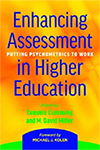Indirect methods of assessment, such as NSSE, provide information about students' perceptions of their performance and their academic environment, as well as how they feel their institution contributes to their learning. An indirect assessment can show how much students feel their experience at the institution has contributed to their growth in areas like critical thinking skills, and may also help to explain students' performance levels. Although indirect assessments do not directly measure facets of learning, they should be used when there is a desire to understand the processes and attitudes that are correlated with the development of that aspect of learning. Even when the connection between direct and indirect assessments of a particular aspect of learning is well-established through extensive review of previous literature and rigorous research studies across a wide variety of contexts, results from indirect assessments should still be interpreted with caution and should never be viewed as a complete substitute for direct knowledge of student learning, particularly for individual students.
Indirect assessments can help provide information on how to make sense of direct assessments in order to make changes. The combination of findings from direct and indirect assessments can also help institutions to evaluate teaching practices, curricula, learning support services, and other programs and events intended to enhance student learning. When connections are made between students' experiences (through indirect assessment) and student learning (through direct assessment), successful pedagogies and practices can be identified and expanded. Students' perceptions of their learning environment can help provide instructional staff with ideas and insight on what might be changed or improved. Similarly the perceptions and experiences of instructional staff can contribute to broadening the conversation on the improvement of the teaching and learning process. Indirect assessments are also a good way to solicit feedback and advice from colleagues and stakeholders on improving the teaching and learning process. Given the vast variability in education on multiple levels (course, department, institution, etc.) it especially makes sense to collect information about the context of student learning in order to make adjustments. Such information collected from indirect assessments can be used to guide improvement processes and advise on where to best deploy time and other resources.
In a recently published chapter in the book Enhancing Assessment in Higher Education, Thomas F. Nelson Laird and Allison BrckaLorenz examine indirect assessments as they are used in higher education. In this chapter, they define indirect assessments, explain common ways in which indirect assessments are conducted, and offer a summary of the strengths and limitations of different version of this type of assessment. They write about closed-ended questioning, open-ended questioning, as well as archival records, as it is through questioning and accessing records that indirect assessment occurs. They define these methods of questioning, explain how these types of questions or records get developed and what methods are used to gather information using these types of questions or records. They additionally summarize the strengths and limitations of each method.


